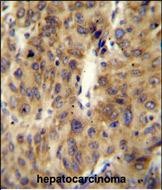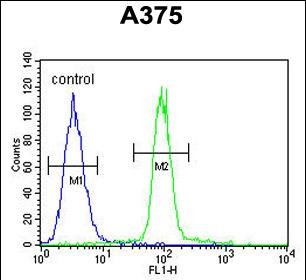ACF Antibody (C-term)
Affinity Purified Rabbit Polyclonal Antibody (Pab)
- SPECIFICATION
- CITATIONS
- PROTOCOLS
- BACKGROUND

Application
| FC, IHC-P, WB, E |
|---|---|
| Primary Accession | Q9NQ94 |
| Other Accession | NP_620310 |
| Reactivity | Human |
| Host | Rabbit |
| Clonality | Polyclonal |
| Isotype | Rabbit IgG |
| Calculated MW | 65202 Da |
| Antigen Region | 394-423 aa |
| Gene ID | 29974 |
|---|---|
| Other Names | APOBEC1 complementation factor, APOBEC1-stimulating protein, A1CF, ACF, ASP {ECO:0000312|EMBL:CAB947541} |
| Target/Specificity | This ACF antibody is generated from rabbits immunized with a KLH conjugated synthetic peptide between 394-423 amino acids from the C-terminal region of human ACF. |
| Dilution | FC~~1:10~50 IHC-P~~1:50~100 WB~~1:1000 E~~Use at an assay dependent concentration. |
| Format | Purified polyclonal antibody supplied in PBS with 0.09% (W/V) sodium azide. This antibody is purified through a protein A column, followed by peptide affinity purification. |
| Storage | Maintain refrigerated at 2-8°C for up to 2 weeks. For long term storage store at -20°C in small aliquots to prevent freeze-thaw cycles. |
| Precautions | ACF Antibody (C-term) is for research use only and not for use in diagnostic or therapeutic procedures. |
| Name | A1CF |
|---|---|
| Synonyms | ACF, ASP {ECO:0000312|EMBL:CAB94754.1} |
| Function | Essential component of the apolipoprotein B mRNA editing enzyme complex which is responsible for the postranscriptional editing of a CAA codon for Gln to a UAA codon for stop in APOB mRNA. Binds to APOB mRNA and is probably responsible for docking the catalytic subunit, APOBEC1, to the mRNA to allow it to deaminate its target cytosine. The complex also protects the edited APOB mRNA from nonsense- mediated decay. |
| Cellular Location | Nucleus. Endoplasmic reticulum Cytoplasm. Note=Predominantly nuclear where it localizes to heterochromatin. Also cytoplasmic where it is found at the outer surface of the endoplasmic reticulum (By similarity). Shuttles between the nucleus and cytoplasm. May be transported into the nucleus by the nuclear import protein TNPO2/TRN2 or by APOBEC1. |
| Tissue Location | Widely expressed with highest levels in brain, liver, pancreas, colon and spleen. |

Thousands of laboratories across the world have published research that depended on the performance of antibodies from Abcepta to advance their research. Check out links to articles that cite our products in major peer-reviewed journals, organized by research category.
info@abcepta.com, and receive a free "I Love Antibodies" mug.
Provided below are standard protocols that you may find useful for product applications.
Background
Mammalian apolipoprotein B mRNA undergoes site-specific C to U deamination, which is mediated by a multi-component enzyme complex containing a minimal core composed of APOBEC-1 and a complementation factor encoded by this gene. The gene product has three non-identical RNA recognition motifs and belongs to the hnRNP R family of RNA-binding proteins. It has been proposed that this complementation factor functions as an RNA-binding subunit and docks APOBEC-1 to deaminate the upstream cytidine. Studies suggest that the protein may also be involved in other RNA editing or RNA processing events.
References
Galloway, C.A., et al. Biochem. Biophys. Res. Commun. 391(1):659-663(2010)
Blanc, V., et al. Mol. Cell. Biol. 25(16):7260-7269(2005)
Deloukas, P., et al. Nature 429(6990):375-381(2004)
Xie, K., et al. Proc. Natl. Acad. Sci. U.S.A. 101(21):8114-8119(2004)
Blanc, V., et al. J. Biol. Chem. 278(42):41198-41204(2003)
If you have used an Abcepta product and would like to share how it has performed, please click on the "Submit Review" button and provide the requested information. Our staff will examine and post your review and contact you if needed.
If you have any additional inquiries please email technical services at tech@abcepta.com.













 Foundational characteristics of cancer include proliferation, angiogenesis, migration, evasion of apoptosis, and cellular immortality. Find key markers for these cellular processes and antibodies to detect them.
Foundational characteristics of cancer include proliferation, angiogenesis, migration, evasion of apoptosis, and cellular immortality. Find key markers for these cellular processes and antibodies to detect them. The SUMOplot™ Analysis Program predicts and scores sumoylation sites in your protein. SUMOylation is a post-translational modification involved in various cellular processes, such as nuclear-cytosolic transport, transcriptional regulation, apoptosis, protein stability, response to stress, and progression through the cell cycle.
The SUMOplot™ Analysis Program predicts and scores sumoylation sites in your protein. SUMOylation is a post-translational modification involved in various cellular processes, such as nuclear-cytosolic transport, transcriptional regulation, apoptosis, protein stability, response to stress, and progression through the cell cycle. The Autophagy Receptor Motif Plotter predicts and scores autophagy receptor binding sites in your protein. Identifying proteins connected to this pathway is critical to understanding the role of autophagy in physiological as well as pathological processes such as development, differentiation, neurodegenerative diseases, stress, infection, and cancer.
The Autophagy Receptor Motif Plotter predicts and scores autophagy receptor binding sites in your protein. Identifying proteins connected to this pathway is critical to understanding the role of autophagy in physiological as well as pathological processes such as development, differentiation, neurodegenerative diseases, stress, infection, and cancer.




